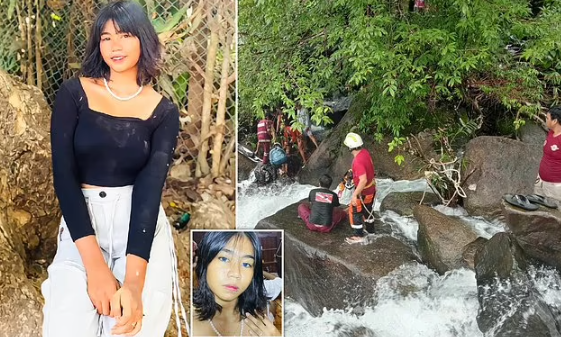A young girl died while taking selfies for her TikTok followers at the top of a waterfall after falling in and drowning while trapped between two rocks.
Moe Sa Nay, 14, was posing for snaps with her friends to share with her 150,000 social media followers when she slipped on the wet stones at the Sinywa Waterfall in south-east Myanmar on July 22.
The teen was swept away downstream by the fast-flowing current and her body was left jammed between two large boulders.
Unable to free herself, Nay drowned as the water crashed around her at the popular tourist destination in the town of Paung in Mon state.
Rescuers dashed to the scene but struggled to retrieve the youngster’s body in time.



Dramatic footage shows volunteers and firefighters battling to dislodge the lifeless girl’s body from the rocks the following morning, on July 23.
They were spotted tying her hands with rope and yanking her out of the narrow gap.
Rescue worker Mon Zaw said: ‘The one who slipped reached the bottom, but died after getting stuck between the rocks.
‘She died because she couldn’t get out. They tried to rescue her but couldn’t pull her out. Then the aid organizations and officials came.’
Moe’s body was taken to the Paung Township General Hospital for a post-mortem examination.
Meanwhile, her friend, who had also slipped down the waterfalls, suffered only minor injuries.
It comes after a beautician, 39, plunged 170ft to her death while taking a selfie from a clifftop panoramic viewing platform in April.
Inessa Polenko had climbed over a barrier then stumbled, falling onto a beach below, according to eyewitnesses.
Paramedics arrived quickly at the scene but she died in hospital after falling from the Gagry viewing point in scenic Abkhazia, a breakaway region of Georgia. The viewing point overlooks the Black Sea.
Also in April, two University of Dundee students drowned after falling into a waterfall ‘while trying to take a selfie’.

Nay, who had 150,000 followers on social media, drowned as the water crashed around her at the popular tourist destination in the town of Paung in Mon state

The teenager was posing for pictures along with her friend who also slipped – but only suffered minor injuries
Jitendranath Karuturi, 26, and Chanhakya Bolisetti, 22, were believed to have been taking pictures at the Linn of Tummel waterfall near Blair Atholl, when they slipped and plunged into the river below.
They were then reportedly swept away, witnessed by a friend who was with them on their walk at the Highlands beauty spot.
Their bodies were recovered by the Scottish fire and rescue service.
It came as new research suggested that taking selfies should be considered a ‘public health problem’.
Academics in Australia analysed scientific papers and media reports on injuries or deaths from selfies worldwide since 2008.
They found nearly 400 had been reported over the 13 years considered in the study.
Victims were most likely to be female tourists in their early 20s, with falling and drowning while taking a photo the leading two causes of death.
Researchers said the public must be made aware of the risks posed by selfies – with an estimated 92million snapped globally every day – and urged social media apps to install software to warn people of the dangers as they go to take a selfie.
Dr Samuel Cornell, a risk expert at the University of New South Wales, Australia, and others wrote in the paper: ‘The selfie-related incident phenomenon should be viewed as a public health problem that requires a public health response.
‘To date, little attention has been paid to averting selfie-related incidents through behavior change methodologies or direct messaging to users through apps.
‘Although previous research has recommended “no selfie zones”, barriers and signage as ways to prevent selfie incidents, our results suggest this may not be enough.
‘It may be prudent to also engage in direct safety messaging to social media users.’



